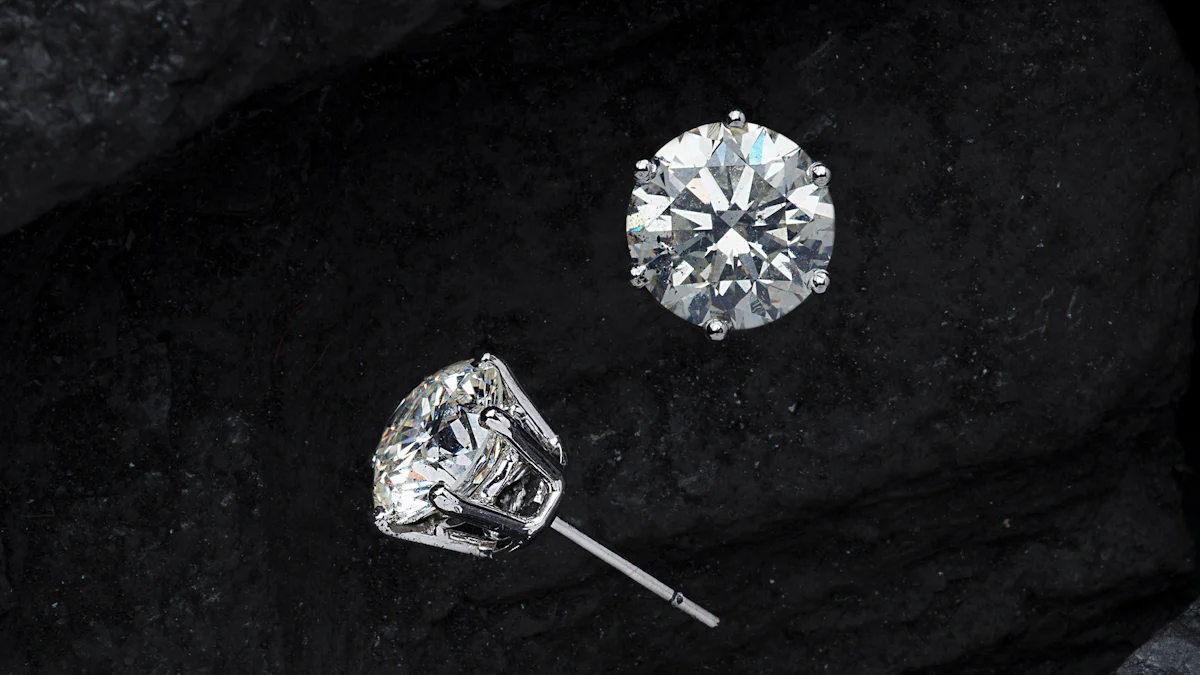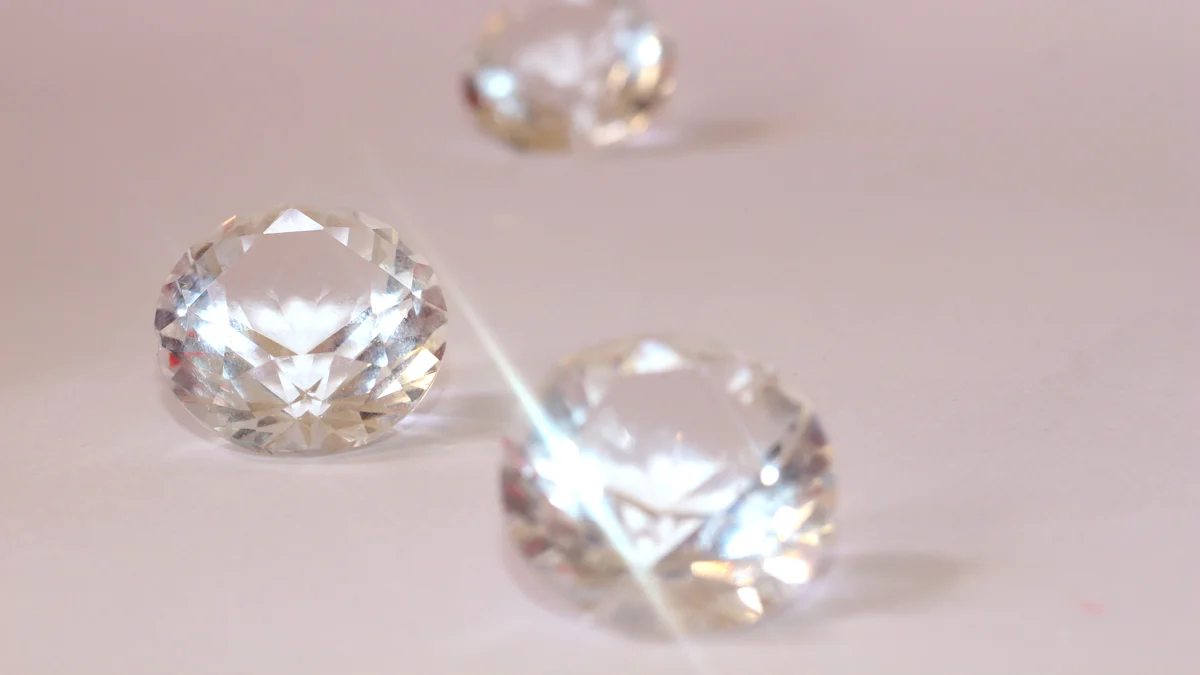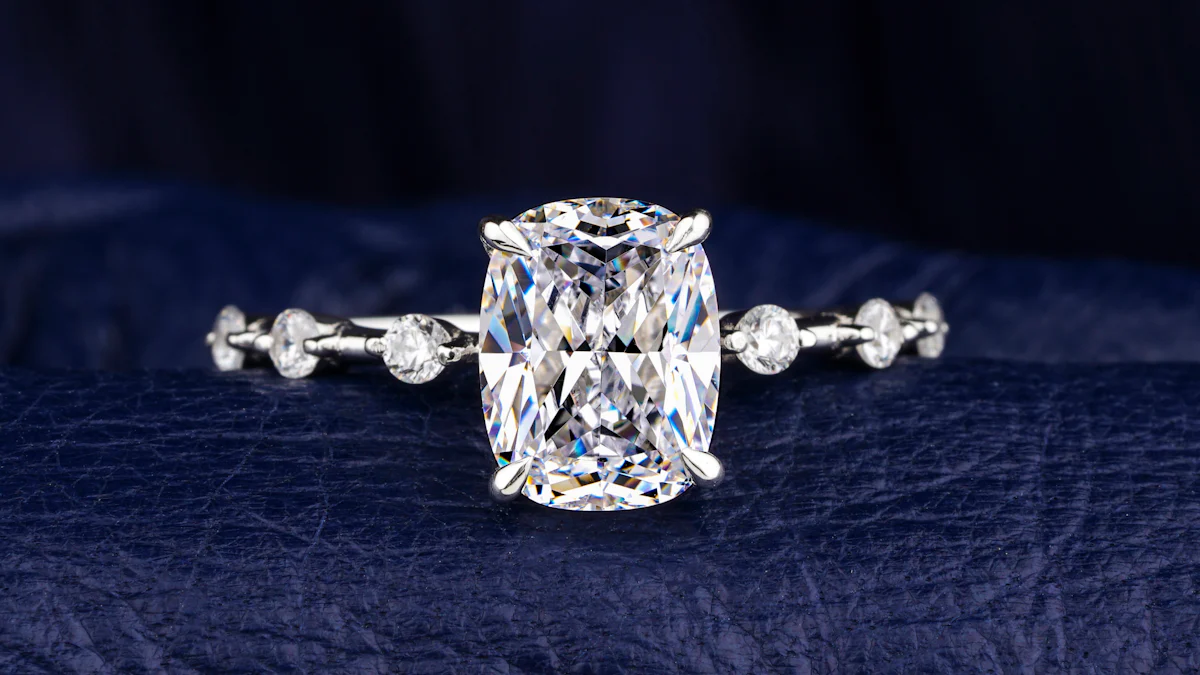Oval Diamond Bow Tie Effect and Its Impact on Quality

Defining the oval diamond bow tie effect reveals its unique visual characteristic—a shadow resembling a bow tie that stretches across the center of an oval diamond. This phenomenon occurs due to the interplay of light and the diamond's facet arrangement. While subtle in some stones, it can dominate the appearance of others. Understanding the oval diamond bow tie effect is crucial, as it directly influences both the brilliance and perceived quality of the diamond. For buyers, evaluating this effect ensures they select an oval diamond that aligns with their aesthetic preferences and expectations for quality.
What Causes the Bow Tie Effect in Oval Diamonds?

The bow tie effect in oval diamonds arises from specific interactions between light and the diamond's structure. This phenomenon is not random but results from precise factors related to the diamond's cut and how it manipulates light. Understanding these causes helps buyers make informed decisions when selecting a diamond.
The Role of Light Behavior
Light behavior plays a critical role in creating the bow tie effect. When light enters a diamond, it reflects and refracts through its facets. In oval diamonds, the elongated shape and facet arrangement can cause uneven light distribution. This unevenness leads to areas where light fails to reflect back to the viewer, forming the characteristic shadow across the center.
According to studies, the bow tie effect occurs when light is not properly reflected due to the diamond's facet positions. These facets dictate how light travels within the stone, influencing its overall brilliance and appearance.
Light leakage is another contributing factor. If the diamond's facets allow light to escape rather than reflect internally, it diminishes the stone's brightness. This leakage often intensifies the bow tie effect, making the shadow more pronounced and noticeable.
Cutting Angles and Proportions
The cut quality of a diamond significantly impacts the presence and severity of the bow tie effect. The angles and proportions of the diamond's facets determine how light interacts with the stone. In oval diamonds, improper cutting angles can disrupt the light performance, leading to the formation of the bow tie shadow.
For example, if the pavilion (the lower part of the diamond) is too shallow or too deep, it alters the light's path. This misalignment causes light leakage, reducing the diamond's brilliance and enhancing the bow tie effect. Similarly, the symmetry of the cut affects how evenly light reflects across the diamond's surface. Poor symmetry often results in an unbalanced appearance, with the bow tie shadow becoming more prominent.
Research highlights that the bow tie effect stems from the specific angles and proportions of a diamond's facets. Properly aligned facets ensure optimal light reflection, minimizing the shadow's impact.
To mitigate the bow tie effect, diamond cutters must prioritize precision. Achieving the right balance between depth, table size, and facet alignment enhances the diamond's light performance and reduces light leakage. This meticulous approach ensures that the diamond retains its brilliance while minimizing undesirable shadows.
How the Bow Tie Effect Impacts Diamond Appearance and Quality
Visual Appearance
The oval diamond bow tie effect significantly alters the visual appeal of a diamond. This shadow, resembling a bow tie, creates dark areas across the center of the stone. These dark zones disrupt the diamond's brilliance, making it appear less lively and vibrant. When light fails to reflect evenly due to improper facet alignment, the diamond loses its sparkle and scintillation. This uneven light performance diminishes the overall appearance of the stone, leaving it looking dull.
Diamonds with a pronounced bow tie effect often draw attention to the shadow rather than the stone's natural beauty. This can overshadow the diamond's other qualities, such as its color or clarity. Buyers should carefully inspect the diamond under various lighting conditions to assess how the bow tie effect influences its brightness and sparkle. Tilting the diamond or using magnification tools can help identify the extent of the shadow and its impact on the stone's brilliance.
Experts emphasize that the bow tie effect results from stretched facets, which hinder light dispersion. This makes the diamond appear less sparkly and reduces its overall charm.
While some minor bow tie effects may add character to the diamond, excessive darkness in the center is generally undesirable. A well-cut oval diamond with minimal shadowing will exhibit better brilliance and a more balanced visual appeal.
Perceived Quality
The bow tie effect also plays a crucial role in shaping the perceived quality of a diamond. A diamond with a severe bow tie shadow often signals issues with its cut quality. Poorly aligned facets or incorrect proportions can lead to light leakage, reducing the stone's brilliance and overall value. This directly impacts the diamond's value, as buyers often associate brilliance with higher quality.
A diamond's cut determines how effectively it reflects light. When the cut fails to optimize light reflection, the bow tie effect becomes more noticeable, detracting from the stone's beauty. This can make even a high-carat diamond appear less valuable. Buyers should prioritize cut quality over carat weight to ensure the diamond delivers maximum brilliance and sparkle.
According to professionals, the bow tie effect is a consequence of an imperfect cut. Reviewing the pros and cons of this phenomenon helps buyers understand its impact on the diamond's overall performance.
Assessing the impact on brilliance is essential when evaluating a diamond. A diamond with minimal or no bow tie effect will exhibit better light reflection, enhancing its brightness and perceived value. Consulting with experts and using tools like magnification can help buyers identify diamonds with superior cut quality and minimal light leakage.
How to Choose an Oval Diamond with Minimal or No Bow Tie Effect

Selecting an oval diamond with minimal or no bow tie effect requires careful evaluation of its cut, light performance, and overall appearance. Buyers should focus on specific strategies to ensure they choose a diamond that meets their expectations for quality and brilliance.
Tips for Visual Inspection
Visual inspection plays a critical role in identifying the bow tie effect in oval diamonds. Buyers should examine the diamond under various lighting conditions to observe how light reflects across its surface. Tilting the diamond at different angles can reveal the extent of the shadow and its impact on the stone's brilliance.
When inspecting, pay close attention to the center of the diamond. A pronounced shadow may indicate issues with the cut quality. Comparing multiple diamonds side by side can help buyers identify subtle differences in light performance and appearance. This hands-on approach ensures a more informed decision when buying a diamond.
Gemologists emphasize that visual inspection is essential for assessing the bow tie effect, as it allows buyers to evaluate the diamond's brilliance and symmetry firsthand.
Using Tools and Expert Guidance
Specialized tools and expert guidance can enhance the process of evaluating diamond cut quality. Magnification tools, such as loupes or microscopes, allow buyers to closely examine the diamond's facets and symmetry. These tools help identify poorly cut stones that may exhibit a severe bow tie effect.
Consulting with gemologists provides additional insight into the diamond's quality. Experts can analyze the diamond's cut proportions and explain how they influence light reflection. Their expertise ensures buyers understand the relationship between cut quality and the bow tie effect.
Gemologists state, "They can provide valuable insight into the quality of the diamond's cut and advise on its effects on light reflection." Their guidance helps buyers avoid poorly cut stones and select diamonds with superior performance.
Prioritizing Cut Quality
Cut quality remains the most important factor when choosing an oval diamond. A well-cut diamond minimizes light leakage and enhances brilliance, reducing the visibility of the bow tie effect. Buyers should prioritize evaluating diamond cut quality over carat weight or other characteristics.
When assessing cut quality, focus on the diamond's symmetry, depth, and table size. Properly aligned facets ensure optimal light reflection, creating a balanced and vibrant appearance. Avoid diamonds with shallow or deep pavilions, as these often lead to uneven light distribution and a more pronounced bow tie effect.
According to experts, "Evaluating diamond cut quality is essential for maximizing brilliance and minimizing undesirable shadows." Buyers should seek diamonds with excellent cut grades to ensure superior light performance and overall quality.
By combining visual inspection, expert guidance, and a focus on cut quality, buyers can confidently select an oval diamond that aligns with their preferences. This approach ensures the diamond delivers exceptional brilliance and minimizes the impact of the bow tie effect.
Common Misconceptions About the Bow Tie Effect
Do All Oval Diamonds Have a Bow Tie?
Not all oval diamonds exhibit the bow tie phenomenon. The visibility of this shadow varies significantly depending on the diamond's cut quality and proportions. Some diamonds display a subtle bow tie effect that adds character, while others show a pronounced shadow that detracts from their brilliance. The presence of this phenomenon depends on how the diamond interacts with light, which is influenced by its facet arrangement and symmetry.
Many buyers mistakenly believe that every oval diamond will have a visible bow tie. This assumption often leads to unnecessary compromises when selecting a stone. In reality, skilled diamond cutters can minimize or even eliminate the bow tie phenomenon by carefully optimizing the angles and proportions of the diamond. For instance, a well-cut oval diamond with precise facet alignment will reflect light more evenly, reducing the shadow's prominence.
"The bow tie effect refers to a shadow that sometimes appears across the center of oval diamonds," experts explain. This highlights that the phenomenon is not a universal trait but rather a result of specific cutting and light performance factors.
When shopping for an oval diamond, buyers should inspect each stone individually. Comparing diamonds side by side under various lighting conditions can reveal differences in how the bow tie phenomenon manifests. This approach ensures a more informed decision, helping buyers select a diamond that aligns with their preferences for brilliance and appearance.
Is the Bow Tie Effect Always a Negative Feature?
The bow tie phenomenon is not inherently negative. While a severe shadow can diminish a diamond's brilliance, a subtle bow tie effect may enhance its visual appeal. Some buyers appreciate the unique character that a faint bow tie adds to an oval diamond, viewing it as a distinguishing feature rather than a flaw.
The perception of the bow tie phenomenon often depends on personal preferences. For some, the shadow creates a sense of depth and dimension, making the diamond appear more dynamic. Others may prioritize maximum brilliance and seek stones with minimal or no bow tie effect. Understanding these preferences is crucial when evaluating diamonds.
According to industry professionals, "The oval diamond bow tie effect is a surefire way to mess up an oval diamond" if it becomes too pronounced. However, they also acknowledge that minor shadows can complement the stone's overall appearance when balanced with excellent cut quality.
Buyers should focus on the diamond's overall light performance rather than fixating solely on the bow tie. A well-cut diamond with a faint bow tie can still deliver exceptional brilliance and sparkle. Consulting with gemologists and using magnification tools can help buyers assess whether the bow tie phenomenon enhances or detracts from the diamond's beauty.
The oval diamond bow tie phenomenon stems from the interplay of light and facet proportions, directly influencing a diamond's brilliance and overall quality. Understanding this effect allows buyers to evaluate how it impacts the stone's appearance and value. Prioritizing cut quality ensures optimal light performance, minimizing undesirable shadows. Consulting experts and using proper tools can further enhance the selection process. By focusing on these factors, buyers can make informed decisions that align with their preferences, ensuring their chosen diamond delivers exceptional sparkle and beauty.
FAQ
How Can You Identify the Bow Tie Effect in a Diamond?
To identify the bow tie effect, examine the diamond under various lighting conditions. Look for a shadow resembling a bow tie across the center of the stone. Tilting the diamond at different angles can help reveal this shadow. A pronounced bow tie effect often indicates issues with the diamond's cut quality. Using magnification tools, such as a loupe, can provide a closer look at the facets and symmetry, which influence the presence of this phenomenon.
Experts recommend inspecting diamonds in natural and artificial light to assess how the bow tie effect impacts their brilliance.
Does Every Oval Diamond Have a Bow Tie Effect?
Not all oval diamonds exhibit a visible bow tie effect. The presence and severity of this shadow depend on the diamond's cut quality and proportions. A well-cut oval diamond with precise facet alignment may show minimal or no bow tie effect. However, poorly cut diamonds often display a more pronounced shadow, which can detract from their brilliance.
According to gemologists, "The bow tie effect is not a universal trait but a result of specific cutting and light performance factors."
Is the Bow Tie Effect Always Undesirable?
The bow tie effect is not inherently negative. While a severe shadow can reduce a diamond's brilliance, a subtle bow tie effect may enhance its character. Some buyers appreciate the depth and dimension it adds to the stone. The desirability of this phenomenon depends on personal preferences and the overall light performance of the diamond.
Industry professionals note that minor bow tie effects can complement a diamond's appearance when balanced with excellent cut quality.
What Causes the Bow Tie Effect in Diamonds?
The bow tie effect occurs due to uneven light distribution within the diamond. This happens when the facets fail to reflect light evenly back to the viewer. Factors such as improper cutting angles, shallow or deep pavilions, and poor symmetry contribute to this phenomenon. These issues disrupt the diamond's light performance, creating the characteristic shadow.
Research highlights that "the bow tie effect stems from the specific angles and proportions of a diamond's facets."
How Does the Bow Tie Effect Impact a Diamond's Value?
A pronounced bow tie effect can lower a diamond's perceived value. It often signals poor cut quality, which reduces the stone's brilliance and sparkle. Buyers typically associate brilliance with higher quality, so a diamond with a severe shadow may appear less valuable. Prioritizing cut quality over carat weight ensures better light performance and overall value.
Can the Bow Tie Effect Be Minimized?
Yes, skilled diamond cutters can minimize the bow tie effect by optimizing the angles and proportions of the diamond's facets. Achieving proper symmetry and alignment enhances light reflection, reducing the visibility of the shadow. Buyers should focus on diamonds with excellent cut grades to ensure minimal bow tie effects.
Gemologists emphasize that precision in cutting is essential for minimizing undesirable shadows and maximizing brilliance.
What Tools Can Help Evaluate the Bow Tie Effect?
Magnification tools, such as loupes or microscopes, allow buyers to closely examine a diamond's facets and symmetry. These tools help identify poorly cut stones with severe bow tie effects. Consulting with gemologists provides additional insights into the diamond's cut quality and light performance, ensuring an informed purchase decision.
Why Are Oval Diamonds More Prone to the Bow Tie Effect?
Oval diamonds are more prone to the bow tie effect due to their elongated shape and facet arrangement. The unique structure of these diamonds often leads to uneven light distribution, which creates the shadow. Proper cutting techniques can mitigate this issue, enhancing the diamond's brilliance and appearance.
How Important Is Cut Quality in Avoiding the Bow Tie Effect?
Cut quality plays a crucial role in avoiding the bow tie effect. A well-cut diamond with precise angles and proportions reflects light evenly, minimizing shadows. Buyers should prioritize cut quality over other factors, such as carat weight, to ensure optimal brilliance and minimal bow tie effects.
Experts state that "evaluating diamond cut quality is essential for maximizing brilliance and minimizing undesirable shadows."
Can Expert Guidance Help When Choosing a Diamond?
Expert guidance is invaluable when selecting a diamond. Gemologists can analyze the stone's cut quality, proportions, and light performance. Their expertise helps buyers understand the relationship between the bow tie effect and the diamond's overall appearance. Consulting with professionals ensures a more confident and informed purchase.
See Also
Exploring The Essentials Of Engagement Ring Diamond Cuts
Key Elements That Influence Diamond Ring Prices
The Fascination Behind Diamond Dust Rings Explained

